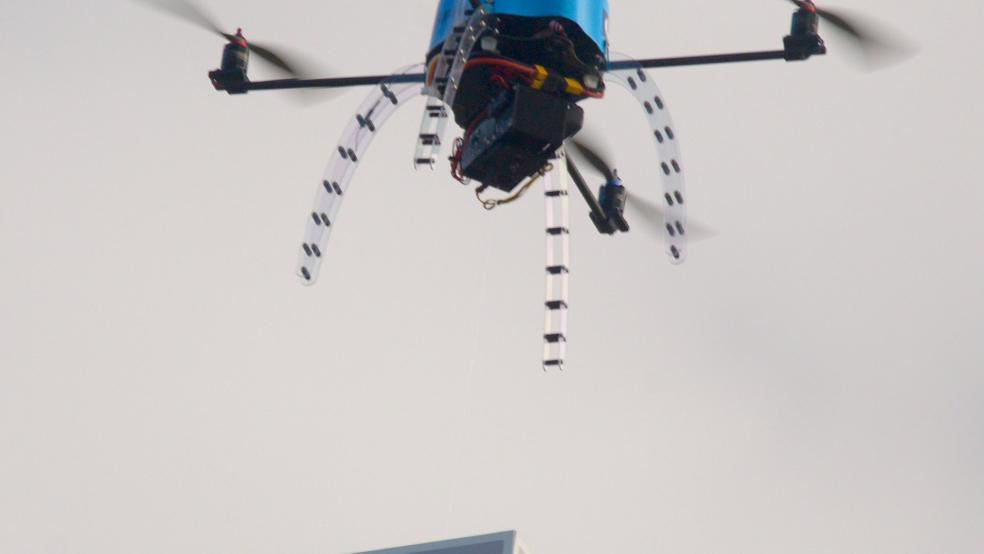On October 2, Peshmerga fighters operating against ISIS near Erbil, Iraq, shot down a small hobby drone, the kind you might buy off of Amazon. But when they investigated the downed device, it exploded, killing them and injuring two French paratroopers, based out of Orleans, according to Le Monde. With that unfortunate blast, it is believed, ISIS claimed its first casualties via a weaponized hobby drone.
It was a surprise to some, but not to all. The U.S. military has been pushing anti-drone tech to U.S. forces in the region with “a sense of urgency,” Lt. Gen. Michael Shields, the director of Joint Improvised Threat-Defeat Organization, or JIDO, told reporters on Wednesday.
Related: Exploding Drones: ISIS Is Arming UAVs You Can Buy on Amazon
At a media event, Shields and other JIDO officials laid out some of the technologies, both operational and in development, to defeat drone-borne bombs and other threats. They include Spynel, a rotating mid-wave infrared camera that fits on a tall tower called the Persistent Surveillance System Ground, or PSS-G, (the towers have been around since the Vietnam War era; Spynel is new.) Even very small drones show up on the operator’s screen in a red square that marks an incoming threat. As well, a company called IMSAR showed off a new drone-mounted, drone-detecting radar.
Along with the sensors, the military is also rushing to equip troops to bring drones down. This summer, someone at the Marine Corps’ Fire Base Bell tweeted a picture of his Battelle DroneDefender, a directed-energy weapon that can disrupt a drone’s control link and GPS navigation at a distance of 400 meters. Battelle reports that they’ve sold more than a hundred to customers within the Pentagon, Department of Homeland Security, and militaries around the world, but getting them in the hands of the Peshmerga has been a challenge. Also, what works in the open desert — shooting electromagnetic energy at drones — may not work in a dense urban environment with lots of consumer electronics around. That could prove a problem when the fighting moves into Mosul.
Related: Five Big Stories You Missed Because You Were Reading About Trump
Continued research into how to use directed energy to down rogue drones in dense cities is “a worthy investment,” said Shields.
“There’s a disciplined process to move through” to getting bomb-detection-and-defeat gear to the front lines, he said. In January and February, JIDO will test state-of-the-art tools for defeating UAVs.
In the weeks and months ahead, as the Iraqi Security Forces (backed up by U.S. special operators) attempt to take Mosul, Shields expects forces to face much bigger and more dangerous improvised explosive threats than bombs strapped to hobby drones. “ISIL does an incredibly good job of booby-trapping” houses, he said, noting lessons learned in Ramadi and Fallujah.
There’s also the threat of tunnel bombs. JIDO has a tool called a direct synthetic electromagnetic gradiometer: basically, a tunnel-finding radar that fits in a tube the size of a coffee Thermos for mounting under a medium-sized drone.
Nifty gadgets all. But, says Shields, “there’s no single technology that’s going to defeat” drone-borne bombs, much less elaborate house and tunnel bombs. Rather, it will be a combination of technology; intelligence collection from the field; and the tactics, techniques and procedures that the military creates as ISIS hurls dangerous new weapons at them.
“We’re developing the [tactics, techniques, and procedure] right now,” says Shields. “So the integration of technology, it’s happening right now.”
This article originally appeared on Defense One. Read more from Defense One:
Got Something to Sell to the Pentagon? It’s About to Get Easier
The Philippines Is About to Give Up the South China Sea to China
Don’t Buy the Bluster. East Asia Is Less Heated Than It Appears: US Diplomat




